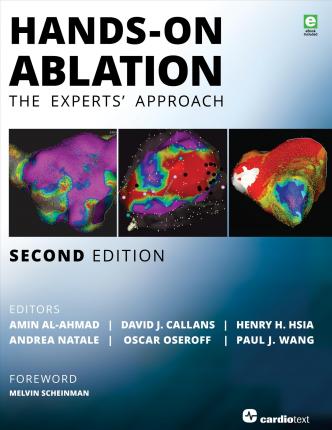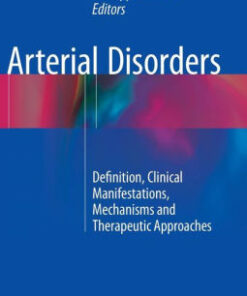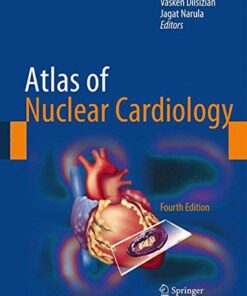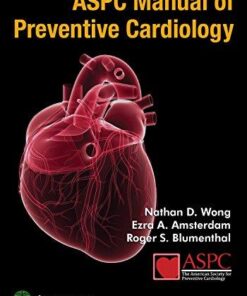(PDF) Hands-On Ablation – The Experts’ Approach 2nd Edition by Amin Al-Ahmad
$18.00
Download instantly Hands-On Ablation – The Experts’ Approach 2nd Edition by Amin Al-Ahmad, David Callans, Henry H. Hsia. It is ebook in PDF format.
ISBN-10: 1942909179 ISBN-13: 9781942909170
Preview
This is the PDF eBook version for Hands-On Ablation – The Experts’ Approach 2nd Edition by Amin Al-Ahmad, David Callans, Henry H. Hsia
Table of Contents
Foreword
Preface
Abbreviations
Video Descriptions
Section I: Ablation of SupraventricularTachycardia
Chapter 1: How to Rapidly Diagnose Supraventricular Tachycardia in the Electrophysiology Lab
Introduction
Preprocedure Planning
Vascular Access and Catheter Placement
Baseline Observations in the EP Lab
Tachycardia Characteristics
Pacing Maneuvers During Tachycardia
Conclusions
References
References
Chapter 2: How to Ablate Typical and Reverse Atrial Flutter
Introduction
Preprocedure Planning
Procedure
Ablation
Differential Pacing
Postprocedure Care
Procedural Complications
Conclusions
References
Chapter 3: How to Ablate Atrial Flutter Postsurgery
Introduction
Preprocedure Planning
Procedure
Postprocedure Care
Procedural Complications
Advantages and Limitations
Conclusions
References
Chapter 4: The Ablation of Atrial Tachycardia
Introduction
Focal Atrial Tachycardia
The Electrophysiological Study
References
Chapter 5: How to Ablate Atrial Tachycardias in Patients with Congenital Heart Disease
Introduction
Preprocedural Planning
Procedure
Postprocedure Care
Procedural Complications
Advantages and Limitations
Conclusions
References
Video Descriptions
Chapter 6: How to Perform Radiofrequency Ablation and Cryoablation for AV Nodal Reentrant Tachycardi
Introduction
Preprocedural Preparation
Procedure
Electrophysiological Testing and Assessment: Pathophysiology of Dual AV Nodal Pathways
Mapping and Diagnosis
Slow-Fast
Slow-Slow
Fast-Slow
Left-Sided Variant
Ablation
Anatomic Approach
Energy Application
Endpoints for Ablation
Efficacy
Complications
Considerations in Children
Postprocedural Care
Conclusions
References
Chapter 7: Ablation of Left-Lateral Accessory Pathways
Introduction
Preprocedural Planning
Procedure
Postprocedure Care
References
Chapter 8: Catheter Ablation of Accessory Pathways
Introduction
Catheter Mapping of Accessory Pathways
Catheter Ablation of APs
Epicardial Posteroseptal APs
References
Chapter 9: Right-Sided Accessory Pathways
Introduction
Classifications
General Considerations
Right Free-Wall Pathways
Anteroseptal Pathways
Midseptal Pathways
Posteroseptal Pathways
Mahaim Tachycardias
Permanent Junctional Reciprocating Tachycardia (PJRT)
New Techniques
How We Approach Right-Sided Pathways
References
Chapter 10: How to Diagnose, Map, and Ablate AVRT Due to Atriofascicular Conduction Fibers
Introduction
Surface Electrocardiogram
Electrophysiology Study
Techniques for Mapping and Ablation
Associated Findings
Conclusions
References
Chapter 11: How to Ablate Accessory Pathways in Patients with Ebstein’s Syndrome
Introduction
Anatomy of Ebstein’s Anomaly
Preprocedural Planning
Procedure
Postprocedure Care
Procedural Complications
Advantages and Limitations
Conclusions
References
Video Description
Section II: Ablation of Atrial Fibrillation
Chapter 12: How to Perform a Transseptal Puncture
Introduction
Preprocedure Planning
Procedure
procedure Care
Procedural Complications
Advantages and Limitations
Conclusions
References
Video Descriptions
Chapter 13: How to Utilize ICE for Optimal Safety and Efficacy with Atrial Fibrillation Ablation
Introduction
Preprocedure Planning
Procedural Imaging
Postprocedural Care
Procedural Complications
Advantages and Limitations
Conclusions
References
Video Descriptions
Chapter 14: How to Perform Pulmonary Vein Antral Isolation for Atrial Fibrillation
Introduction
Preprocedural Planning
Procedure
Postprocedure Care
Procedural Complications
Conclusions
References
Video Descriptions
Chapter 15: How to Utilize Noninvasive Guidance for Persistent Atrial Fibrillation
Introduction
Noninvasive Analysis of AF
Noninvasive AF-Mapping Technique
Distribution and Characteristics of Localized AF Drivers
Noninvasive Mapping-Guided Ablation
Single Procedural and Clinical Outcomes of Driver Ablation
Limitations and Promises
Conclusion
References
Chapter 16: How to Ablate Long-Standing Persisten tAtrial Fibrillation Using a Stepwise Approach: Th
Introduction
Preprocedural Management
Anesthesia Protocol
Instrumentation for Electrophysiological Study
Pulmonary Vein Antral Isolation (PVAI) and Isolation of the SVC
Other Targets
Considerations for Patients Presenting for Repeat Procedure
Postprocedural Care and Follow-Up
References
Video Descriptions
Chapter 17: How to Use Balloon Cryoablation for Ablation of Atrial Fibrillation
Introduction
Preprocedure Planning
Procedure
Postprocedure Care
Procedural Complications
Advantages and Limitations
Conclusions
References
Chapter 18: How to Perform Pulmonary Vein Isolation Using Laser Catheter Ablation
Background
Left Atrium Access and Balloon Deployment
Laser Ablation
Checking for PVI
Clinical Data
Summary
References
Video Description
How to Use the Radiofrequency Hot Balloon for Ablation of Atrial Fibrillation
Introduction
Radiofrequency Hot Balloon Design
Mechanism of Radiofrequency Hot Balloon Ablation
Clinical Ablation with the Radiofrequency Hot Balloon Catheter Ablation System
Clinical Studies
Conclusions
References
Chapter 20: How to Perform Ethanol Ablation of the Vein of Marshall
Introduction
Procedure
Risks of Ethanol Injection in the VOM
Conclusions
References
Video Description
Chapter 21: How to Ablate the Vein of Marshall
Introduction
The Anatomy of Ligament of Marshall
Electrophysiological Characteristics of the Marshall Bundle
Methods of Marshall Bundle Mapping
Catheter Ablation of the Marshall Bundle
Ethanol Ablation of the Marshall Bundle
Additional Implications for CatheterAblation of AF
References
Chapter 22: Diagnosis and Ablation of Atrial Tachycardias Arising in the Context of Atrial Fibrillat
Introduction
Incidence of Atrial Tachycardia After AF Ablation
Classification of Atrial Tachycardia
Mechanisms of Atrial Tachycardia
Drug Therapy
Locations of Atrial Tachycardia Circuits
Diagnosis
Catheter Ablation
Procedural Outcome and Prognosis
Prevention of AT
Conclusion
References
Chaper 23: How to Perform 3-Dimensional Entrainment Mapping to Treat Post–AF Ablation Atrial Tachy
Introduction
Preprocedural Planning
Procedure
Mapping
Postprocedure Care
Procedural Complications
Advantages and Limitations
Conclusion
References
Video Descriptions
Chapter 24: Catheter Ablation of Autonomic Ganglionated Plexi in Patients with Atrial Fibrillation
Introduction
Localization of LA Ganglionated Plexi by Endocardial High-Frequency Stimulation
Catheter Ablation of LA Ganglionated Plexi
References
Chapter 25: How to Perform Rotor Mapping for Atrial Fibrillation Ablation
Introduction
Clinical Basis of FIRM-Guided Rotor Ablation
Mapping the Atria with Basket Catheters
Interpreting Spatial Maps of AF Activity
Method of FIRM-Guided Ablation
Endpoint of Rotor Ablation
Conclusions
References
Chapter 26: How to Utilize Frequency Analysis to Aid in Atrial Fibrillation Ablation
Introduction
Preprocedural Planning: Technological Considerations
Procedure
A Novel Method for Substrate Mapping in Persistent Atrial Fibrillation: Hilbert-Huang Transformation
Clinical Perspective
Limitations
Conclusions
References
Video Descriptions
Chapter 27: How to Use Electroanatomic Mapping to Rapidly Diagnose and Treat Post–AF Ablation Atr
Introduction
Preprocedure Planning
Mapping and Ablation of Postablation AT
LA Macroreentrant ATs
Postprocedure Care
Procedural Outcomes
Advantages and Limitations ofActivation Mapping
Conclusions
References
Chapter 28: Utilization of the Hansen Robotic Catheter Navigation System: The Austin Approach
Introduction
Background
Description of the Hansen System
Transseptal Access
Robotic Navigation and Force Sensing Catheters
Ablation Lesion Sets
References
Video Descriptions
Chapter 29: Hybrid Minimal Invasive Epicardial and Transvenous Catheter Ablation for Atrial Fibrilla
Introduction
Anatomy
Hybrid Procedure
Ablation Devices
Complications
Patient Selection
Anticoagulation and Antiarrhythmic Drugs
Early Recurrence of Atrial Fibrillation
Atrial Tachycardias
Clinical Studies and Randomized Controlled Trials
Conclusions
References
Video Descriptions
Chapter 30: How to Perform Accurate Image Registration with Electroanatomic Mapping Systems
Introduction
Preprocedural Planning
Procedure
Registration
Factors Affecting Integration Error
Postprocedure Care
Procedural Complications
Advantages and Limitations
Conclusions
References
Chapter 31: How to Perform Atrial Fibrillation Ablation without the Use of Fluoroscopy
Introduction
Required Equipment
Preprocedure Preparation
Procedure
Discussion
Conclusion
References
Video Description
Section III: Ablation of Ventricular Tachycardia
Chapter 32: How to Localize Ventricular Tachycardia Using a 12-Lead ECG
Introduction
Bundle Branch Reentrant Ventricular Tachycardia
Ventricular Tachycardia in Patients with Coronary Artery Disease
Idiopathic Ventricular Tachycardias
ECG Characteristics of Epicardial Ventricular Tachycardias
Conclusion
References
Chapter 33: How to Diagnose and Ablate Ventricular Tachycardia from the Outflow Tract and Aortic Cus
Introduction
Preprocedural Planning
Procedure
Postprocedural Care
Procedural Complications
Conclusions
References
Chapter 34: How to Diagnose and Ablate Ventricular Tachycardia from the Papillary Muscles
Introduction
Preprocedural Planning
Procedure
Complications
Postablation Care
References
Video Descriptions
Chapter 35: How to Ablate Non-Outflow Right Ventricular Tachycardia
Introduction
Preprocedure Planning
Mapping and Ablation
Cardiac Crux-Coronary Venous
Potential Complications
Postprocedure Care
Conclusion
References
Chapter 36: How to Map and Ablate Parahisian Ventricular Arrhythmias
Introduction
Anatomy
Electrocardiographic Characteristics
Mapping and Ablation
Outcomes and Complications of Catheter Ablation
Cryoablation
Conclusion
References
Chapter 37: How to Ablate Ventricular Tachycardia from the Left Ventricular Summit
Introduction
Anatomic Landmarks
Electrocardiographic Features
How to Map LVS VAs
Radiofrequency Catheter Ablation of LVS VAs
Outcomes of Catheter Ablation of LVS Arrhythmias
Potential Complications
Alternative Approaches and Future Directions
Summary
References
Chapter 38: How to Diagnose and Ablate Fascicular Ventricular Tachycardia
Introduction
Preprocedural Planning
Procedure
Postprocedure Care
Procedural Complications
Advantages and Limitations
Conclusions
References
Chapter 39: How to Map and Ablate Hemodynamically Tolerated Ventricular Tachycardias
Introduction
Preprocedural Planning
Evaluation of Cardiac Function and Wall Motion
Procedure
Substrate Mapping
Mapping During Hemodynamically Stable VT
Ablation
Future Development
Postprocedure Care
Procedural Complications
Conclusion
References
Chapter 40: How to Map and Ablate Unstable Ventricular Tachycardia:The University of Colorado and U
Introduction
Preprocedural Planning
Procedure
Epicardial Mapping
Ablation
Postprocedure Care
Follow-Up
Repeat Ablations
Procedural Complications
Conclusions
References
Chapter 41: How to Map and Ablate Unstable Ventricular Tachycardia: The Brigham Approach
Introduction
Preprocedural Planning
Procedure
Ablation
Postprocedure Care
Procedural Complications
Advantages and Limitations
Conclusions
References
Video Descriptions
Chapter 42: How to Map and Ablate Ventricular Tachycardia Using Delayed Potential in Sinus Rhythm
Introduction
Preprocedural Planning
Procedure
Postprocedure Care
Advantages and Limitations
Conclusions
References
Video Descriptions
Chapter 43: How to Utilize Electroanatomical Mapping to Identify Critical Channels for Ventricular T
Introduction
Preprocedural Planning
Procedure
Future Development
Postprocedure Care
Procedural Complications
Limitations
Summary
References
Chapter 44: How to Use ICE to Aid in Catheter Ablation of Ventricular Tachycardia
Introduction
Preprocedural Planning
Procedure
Postprocedure Care
Procedural Complications
Advantages and Limitations
Conclusions
References
Video Descriptions
Chapter 45: How to Perform an Epicardial Access
Introduction
Before Scheduling the Pericardial Space Access
Preventing Complications
How to Manage Pericardial Access Complications
Conclusion
References
Video Descriptions
Chapter 46: Transcoronary Ethanol Ablation for Ventricular Tachycardia
Introduction
Preprocedural Preparation
Intraoperative Requirements
Procedure
Complications and Safety
Conclusions
References
Chapter 47: How to Perform Epicardial Ablation in Postcardiac Surgery Patients
Introduction
Preprocedural Planning
Complications
Conclusion
References
Chapter 48: How to Perform Endocardial/Epicardial Ventricular Tachycardia Ablation
Introduction
Preprocedural Planning
Procedure
Follow-Up
Advantages and Limitations
Conclusion
References
Video Descriptions
Chapter 49: How to Ablate Ventricular Fibrillation Arising from the Structurally Normal Heart
Introduction
What Do We Know About VF?
Preprocedural Planning for VF Ablation
Procedure
Follow-Up After VF Ablation
References
Chapter 50: How to Ablate Ventricular Tachycardia in Patients with Congenital Heart Disease
Introduction
Preprocedural Planning
Procedure
Postprocedure Care
Procedural Complications
Advantages and Limitations
Conclusions
References
Video Descriptions
Chapter 51: Mapping and Catheter Ablation for Ventricular Tachycardia Associated with Hypertrophic C
Introduction
References
Chapter 52: How to Ablate Ventricular Tachycardia in Patients with Arrhythmogenic Right Ventricular
Introduction
Preprocedural Planning
Ablation Procedure
Prevention and Management of Procedural Complications
Postprocedural Care
Patient Follow-Up
Conclusions
References
Video Description
Chapter 53: How to Ablate Ventricular Tachycardia/Ventricular Fibrillation in Patients with the Brug
Introduction
The Trigger Approach
The Substrate Approach
Conclusions
References
Chapter 54: How to Perform Surgical Ventricular Tachycardia Ablation in a Hybrid Lab
Introduction
Rationale and Indications
Pericardial Adhesions
Failed Ablation Via Percutaneous Approach
Choice of Surgical Approach
Preprocedural Planning and Tools
Conclusions
References
Chapter 55: How to Use Pace Mapping to Identify the Critical Isthmus
Introduction
Technical Aspects of Pace Mapping
Characteristics of Pace Mapping Along Postinfarct VT Isthmuses
How to Use Pace Mapping for the Delineation of a Postinfarct VT Isthmus
Limitations
Summary
References
Video Descriptions
Chapter 56: How to Ablate Scar-Related Ventricular Tachycardia Using Isochronal Late Activation Mapp
Introduction
Background
General Procedural Approach
Creation of Isochronal Late Activation Map
Advantages and Limitations
Conclusions
References
Chapter 57: How to Use Ventricular Assist Devices to Facilitate Ablation of Hemodynamically Unstable
Introduction
Patient Selection
Percutaneous Hemodynamic Support Devices
Intra-Aortic Balloon Pump Counterpulsation
Hemodynamic Assessment During Ablation
Complications
Conclusion
References
Video Descriptions
Section IV: Miscellaneous Procedures
Chapter 58: How to Implant a Watchman Device
Introduction
Venous Access and Transseptal Puncture
Selection of Device Size and Device Preparation
Venous Closure and Postprocedure Management
Complications
References
Video Descriptions
Chapter 59: How to Close the Left Atrial Appendage Using Endocardial and Epicardial Approach
Introduction
LARIAT
Watchman
Other LAA Closure Devices
Conclusion
References
Index




